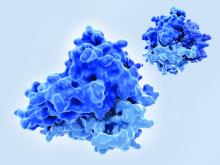User login
Dear colleagues,
We shift gears from discussing GI hospitalists to focusing on the treatment of inflammatory bowel disease. The introduction of anti-TNFs brought about a paradigm shift in IBD management. With the ability to measure drug and antibody levels, we are also able to alter dose and timing to increase the efficacy of these medications. Some experts have extended this reactive drug monitoring approach to a more proactive method with the expectation that this may prevent loss of efficacy and development of adverse events. Dr. Loren G. Rabinowitz and colleagues and Dr. Hans Herfarth describe these two approaches to anti-TNF management in IBD, drawing from the current data and their own experiences. I look forward to hearing your thoughts and experiences by email ([email protected]).
Gyanprakash A. Ketwaroo, MD, MSc, is an assistant professor of medicine at Baylor College of Medicine, Houston. He is an associate editor for GI & Hepatology News.
Better outcomes than reactive TDM
By Loren G. Rabinowitz, MD; Konstantinos Papamichael, PhD, MD; and Adam S. Cheifetz, MD, AGAF
Therapeutic drug monitoring (TDM), or the practice of treatment optimization based on serum drug concentrations, is used in many settings, including solid organ transplantation, infection, and immune-mediated inflammatory diseases, including inflammatory bowel disease (IBD). In IBD, the use of TDM has been an area of keen research focus, and, in our view, should be standard practice for optimization of biologic therapy, particularly in the setting of anti–tumor necrosis factor (TNF) therapy. TDM has demonstrated utility in determining the correct timing and dosage of biologics and can provide the impetus for deescalating or discontinuing a biologic in favor of an alternative one. It also allows prescribers the ability to protect patients from severe infusion reactions if they have developed anti-drug antibodies (ADAs).
Reactive TDM refers to a strategy of assessing drug concentration and presence of ADAs in the setting of primary nonresponse (PNR) and loss of response (LOR) to a biologic agent. In this context, TDM informs possible reasons for loss or lack of response to treatment – for example, insufficient drug concentration or the development of high-titer ADAs (immunogenicity) – thus better directing the management of these unwanted outcomes.1 Insufficient anti-TNF concentrations have been associated with PNR and lack of clinical remission at 1 year in patients with IBD,2 which underscores the need for a durable strategy to ensure appropriate drug concentrations from the induction through maintenance phases of biologic administration. Reactive TDM can also be used to inform the decision to abandon a particular therapy in favor of a different biologic and to guide the selection of the next biologic agent, and has been shown to be less expensive than empiric dose escalation.2 With regard to infliximab and adalimumab, it is our practice to continue dose escalation until drug concentrations are above 10-15 mcg/mL prior to abandoning therapy.1
For a significant number of patients, reactive TDM identifies at-risk patients too late, when ADAs have already formed. Because the number of medications to treat IBD remains limited, waiting for a patient to lose response to an agent, particularly anti-TNF therapies, increases the likelihood of immunogenicity, thus rendering an agent unusable. Proactive TDM or checking drug trough concentrations preemptively and at predetermined intervals, and dosing to an appropriate concentration, can improve patient outcomes. If drug concentration is determined to be not “at target,” dosage and timing of administration can be increased with or without the addition of an immunomodulator (thiopurines or methotrexate) to optimize the biologic’s efficacy and prevent immunogenicity. This approach allows the provider to anticipate and proactively guard against PNR and future LOR.
Proactive TDM of anti-TNF therapy has been associated with better patient outcomes in both pediatric and adult populations when compared with empiric dose optimization and/or reactive TDM.2,3 In patients with immune-mediated inflammatory diseases undergoing maintenance therapy with infliximab, proactive TDM was found to be more effective than treatment without TDM in sustaining disease control without disease worsening.4 Proactive TDM has been associated with better patient outcomes, including increased rates of clinical remission in both pediatric and adult populations and decreased rates of IBD-related surgery, hospitalization, serious infusion reactions, and development of ADAs, when compared with reactive TDM or empiric optimization. Preliminary data suggest that proactive TDM can also be used to efficiently guide dose deescalation in patients in remission with drug concentrations markedly above target and to allow for optimization of infliximab monotherapy so that combination therapy can be employed more judiciously (that is, in a patient who developed rapid ADA to a different anti-TNF).1 This could potentially attenuate the risks associated with long-term immunomodulator use, which include lymphomas and higher rates of serious and opportunistic infections. A recent study using a pharmacokinetic dashboard showed that the majority of patients with IBD will need accelerated dosing by the third infusion to maintain therapeutic infliximab concentrations during induction and maintenance therapy, highlighting the urgent need for widespread adoption of early proactive TDM.5 It is likely that proactive TDM is most important early in therapy when patients are most inflamed and have more rapid drug clearance. For this reason, proactive TDM should ideally be used for all patients during the induction phase. It is our practice to continue to follow drug concentrations one or two times per year once a patient has achieved remission. A recent literature review and consensus statement highlights the utility of TDM and what is known at this time.1
TDM should be standard of care for patients with IBD. At minimum, reactive TDM has rationalized the management of PNR, is associated with better outcomes, and is more cost effective than empiric dose escalation.1,2 In this setting, however, many patients have already developed ADAs that cannot be overcome. At present, anti-TNF therapy remains the most effective agent for our sickest patients with IBD. Given the as-yet limited armamentarium of medications available, particularly for patients with fistulizing perianal Crohn’s disease (CD) and severe ulcerative colitis (UC), proactive TDM, which allows for improved optimization and long-term durability of biologics, is essential to the care of any IBD patient requiring these medications. Proactive TDM should ideally be used for all patients during the induction phase and at least once during maintenance therapy. There is also the potential for TDM-driven dose de-escalation for patients in remission and optimization of infliximab monotherapy, thus avoiding combination therapy with an immunomodulator in some cases. Future perspectives for a more precise application of TDM include the use of pharmacokinetic modeling dashboards and pharmacogenetics toward achieving truly individualized medicine.3
Dr. Rabinowitz, Dr. Papamichael, and Dr. Cheifetz are with the department of medicine and division of gastroenterology at Beth Israel Deaconess Medical Center and Harvard Medical School, both in Boston. Dr. Rabinowitz reports no conflicts of interest. Dr. Papamichael reports lecture fees from Mitsubishi Tanabe Pharma and Physicians’ Education Resource; consultancy fee from Prometheus Laboratories; and scientific advisory board fees from ProciseDx and Scipher Medicine Corporation. Dr. Cheifetz reports consulting for Janssen, AbbVie, Samsung, Arena Pharmaceuticals, Grifols, Prometheus, Bristol Myers Squibb, Artizan Biosciences, Artugan Therapeutics, and Equillium.
References
1. Cheifetz AS et al. Am J Gastroenterol. 2021 Oct 1;116(10):2014-25.
2. Kennedy NA et al. Lancet Gastroenterol Hepatol. 2019 May;4(5):341-53.
3. Papamichael K et al. Lancet Gastroenterol Hepatol. 2022;7(2):171-85.
4. Syversen SW et al. JAMA. 2021;326(23):2375-84.
5. Dubinsky MC et al. Inflamm Bowel Dis. 2022 Jan 3. doi: 10.1093/ibd/izab285.
Taking a closer look at the evidence
By Hans Herfarth, MD, PhD, AGAF
The debate of therapeutic drug monitoring (TDM) in the setting of anti–tumor necrosis factor (TNF) therapy has been ongoing for more than a decade. Reactive TDM, the measurement of drug concentrations in the context of loss of treatment response, is now generally accepted and recommended in multiple national and international inflammatory bowel disease (IBD) guidelines. Proactive TDM, defined as the systematic measurement of drug trough concentrations and anti-drug antibodies with dose adaptations to a predefined target drug concentration, seems to offer a possibility to stabilize drug levels and prevent anti-drug antibody formation due to low systemic drug levels, thus potentially preventing the well-known loss of response to anti-TNF therapy, which occurs in more than 50% of patients over time. However, proactive TDM is not endorsed by evidence-based guidelines, dividing IBD physicians into believers and nonbelievers and limiting uptake into clinical practice.
As with reactive TDM, one should assume that the framework for proactive TDM should have been reliably established based on factual data derived from prospective controlled studies and not rely on retrospective cohorts or “Expert Panel” consensus statements. And indeed, several prospective controlled studies with sizable IBD patient cohorts have been published. Of note, all TDM studies for IBD were conducted in patients on anti-TNF maintenance therapy, and currently no prospective studies in larger IBD populations are available for proactive TDM during induction therapy. Two prospective studies, the PRECISION and the NOR-DRUM trial, report that proactive TDM is better than no TDM at all.
However, in the comparison of proactive TDM and reactive TDM (including at least one drug adaptation in maintenance or drug escalation based on clinical symptoms or biomarkers), three studies have demonstrated no significant differences in drug persistence or overall maintenance of clinical remission. Only a fourth (the pediatric PAILOT study) reported a lower frequency of mild flares and less steroid exposure in the proactive TDM arm over 1 year, but it did not show differences in drug persistence or overall clinical remission compared with the reactive TDM arm. Interestingly, the differences in flare frequency were apparent only in patients on monotherapy but not in the subgroup on combination therapy with an immunomodulator, stressing the well-known beneficial effect of a combination therapy with thiopurines in CD first shown in the SONIC trial.
One problem, at least in the TDM trials with infliximab (IFX), may have been a delay in optimizing IFX levels until the next drug infusion because of the turnaround time of the drug assays. However, even the most recently published ultra-proactive TDM study with ad hoc dose adjustments based on
The value of proactive TDM in induction therapy remains an ongoing concern. There is no doubt that the severity of intestinal inflammation with subsequent loss of drug in the intestine can result in low drug serum concentrations correlating to lower clinical responses and higher rates of immunogenicity with the formation of anti-drug antibodies. A recent study including patients with chronic immune-mediated inflammatory diseases such as IBD, rheumatoid arthritis, and psoriasis did not find a value in proactive TDM of IFX in the induction phase, but more severe IBD may have been underrepresented in this study. Administration of significantly higher induction dosing of adalimumab (160 mg weeks 0, 1, 2, and 3) with significantly higher trough levels compared with a standard induction regimen in the SERENE study has not been shown to increase the short- or long-term remission rates in UC or CD patients. Therefore, higher trough levels in a patient population do not automatically result in better outcomes, but proactive TDM may still have found a few patients who may have benefited from an even higher induction regimen. The UC and CD SERENE maintenance studies also evaluated proactive TDM versus clinical adjustment based on clinical and biomarkers. After 1 year, no differences in the efficacy endpoints of clinical, endoscopic, and deep remission were found. These somewhat surprising results, which have been reported only in meeting abstracts, suggest that simply increasing trough levels to a higher target (one of the primary aims of proactive TDM) is not an effective universal approach for achieving higher remission rates in induction or better outcomes in maintenance. Instead, the SERENE data show that similar results can be achieved by regular clinical follow-up and monitoring of loss of response based on symptoms and/or biochemical markers followed by drug adaptation (which may then also be based on reactive TDM).
One unquestionable effect of proactive TDM is that the process of checking and controlling drug levels suggests for the treating physician better control over the anti-TNF therapy and for the patient reassurance that the treatment is in the intended target range. Proactive TDM also may be cost effective in the group of patients whose anti-TNF treatment regimen can be deescalated because of high drug levels. Despite the increased number of studies showing no clinical advantage of proactive TDM of every patient on anti-TNF therapy, there may be benefits for subgroups. Proactive TDM with point-of-care testing of drug levels may be helpful during induction therapy in patients with a high inflammatory burden, which results in uncontrolled drug loss via the intestine. Proactive TDM during maintenance therapy (for example, every 6-12 months) may be beneficial in subgroups of patients at risk for developing low anti-TNF levels or anti-drug antibodies, such as patients with a genetic predisposition to anti-TNF anti-drug antibody formation (such as the HLA-DQ1*05 allele), patients on a second anti-TNF therapy after loss of response to the first one, and patients on anti-TNF therapy in combination with thiopurines or methotrexate who deescalate to anti-TNF monotherapy.
In summary, there is no doubt that proactive TDM is better than no TDM (meaning no drug adjustments at all). However, nearly all controlled prospective studies show no significant benefit of proactive TDM versus reactive TDM or drug escalation based on clinical symptoms or biomarkers. Future studies should target clearly defined patient groups at risk of losing response to anti-TNF to clarify if proactive TDM is a valuable tool to achieving better therapeutic results in clinical practice.
Dr. Herfarth is professor of medicine and codirector of the UNC Multidisciplinary IBD Center at University of North Carolina at Chapel Hill. He reports serving as a consultant to Alivio Therapeutics, AMAG, Bristol Myers Squibb, Boehringer Ingleheim, ExeGi Pharma, Finch, Gilead, Janssen, Lycera, Merck, Otsuka, Pfizer, PureTech, and Seres and receiving research support from Allakos, Artizan Biosciences, and Pfizer.
Relevant resources
- Syversen SW et al. JAMA. 2021;326:2375-84.
- Strik AS et al. Scand J Gastroenterol. 2021 Feb;56(2):145-54.
- Bossuyt P et al. J Crohns Colitis. 2022 Feb 23;16(2):199-206.
- D’Haens G et al. Gastroenterology. 2018;154:1343-51.e1.
Dear colleagues,
We shift gears from discussing GI hospitalists to focusing on the treatment of inflammatory bowel disease. The introduction of anti-TNFs brought about a paradigm shift in IBD management. With the ability to measure drug and antibody levels, we are also able to alter dose and timing to increase the efficacy of these medications. Some experts have extended this reactive drug monitoring approach to a more proactive method with the expectation that this may prevent loss of efficacy and development of adverse events. Dr. Loren G. Rabinowitz and colleagues and Dr. Hans Herfarth describe these two approaches to anti-TNF management in IBD, drawing from the current data and their own experiences. I look forward to hearing your thoughts and experiences by email ([email protected]).
Gyanprakash A. Ketwaroo, MD, MSc, is an assistant professor of medicine at Baylor College of Medicine, Houston. He is an associate editor for GI & Hepatology News.
Better outcomes than reactive TDM
By Loren G. Rabinowitz, MD; Konstantinos Papamichael, PhD, MD; and Adam S. Cheifetz, MD, AGAF
Therapeutic drug monitoring (TDM), or the practice of treatment optimization based on serum drug concentrations, is used in many settings, including solid organ transplantation, infection, and immune-mediated inflammatory diseases, including inflammatory bowel disease (IBD). In IBD, the use of TDM has been an area of keen research focus, and, in our view, should be standard practice for optimization of biologic therapy, particularly in the setting of anti–tumor necrosis factor (TNF) therapy. TDM has demonstrated utility in determining the correct timing and dosage of biologics and can provide the impetus for deescalating or discontinuing a biologic in favor of an alternative one. It also allows prescribers the ability to protect patients from severe infusion reactions if they have developed anti-drug antibodies (ADAs).
Reactive TDM refers to a strategy of assessing drug concentration and presence of ADAs in the setting of primary nonresponse (PNR) and loss of response (LOR) to a biologic agent. In this context, TDM informs possible reasons for loss or lack of response to treatment – for example, insufficient drug concentration or the development of high-titer ADAs (immunogenicity) – thus better directing the management of these unwanted outcomes.1 Insufficient anti-TNF concentrations have been associated with PNR and lack of clinical remission at 1 year in patients with IBD,2 which underscores the need for a durable strategy to ensure appropriate drug concentrations from the induction through maintenance phases of biologic administration. Reactive TDM can also be used to inform the decision to abandon a particular therapy in favor of a different biologic and to guide the selection of the next biologic agent, and has been shown to be less expensive than empiric dose escalation.2 With regard to infliximab and adalimumab, it is our practice to continue dose escalation until drug concentrations are above 10-15 mcg/mL prior to abandoning therapy.1
For a significant number of patients, reactive TDM identifies at-risk patients too late, when ADAs have already formed. Because the number of medications to treat IBD remains limited, waiting for a patient to lose response to an agent, particularly anti-TNF therapies, increases the likelihood of immunogenicity, thus rendering an agent unusable. Proactive TDM or checking drug trough concentrations preemptively and at predetermined intervals, and dosing to an appropriate concentration, can improve patient outcomes. If drug concentration is determined to be not “at target,” dosage and timing of administration can be increased with or without the addition of an immunomodulator (thiopurines or methotrexate) to optimize the biologic’s efficacy and prevent immunogenicity. This approach allows the provider to anticipate and proactively guard against PNR and future LOR.
Proactive TDM of anti-TNF therapy has been associated with better patient outcomes in both pediatric and adult populations when compared with empiric dose optimization and/or reactive TDM.2,3 In patients with immune-mediated inflammatory diseases undergoing maintenance therapy with infliximab, proactive TDM was found to be more effective than treatment without TDM in sustaining disease control without disease worsening.4 Proactive TDM has been associated with better patient outcomes, including increased rates of clinical remission in both pediatric and adult populations and decreased rates of IBD-related surgery, hospitalization, serious infusion reactions, and development of ADAs, when compared with reactive TDM or empiric optimization. Preliminary data suggest that proactive TDM can also be used to efficiently guide dose deescalation in patients in remission with drug concentrations markedly above target and to allow for optimization of infliximab monotherapy so that combination therapy can be employed more judiciously (that is, in a patient who developed rapid ADA to a different anti-TNF).1 This could potentially attenuate the risks associated with long-term immunomodulator use, which include lymphomas and higher rates of serious and opportunistic infections. A recent study using a pharmacokinetic dashboard showed that the majority of patients with IBD will need accelerated dosing by the third infusion to maintain therapeutic infliximab concentrations during induction and maintenance therapy, highlighting the urgent need for widespread adoption of early proactive TDM.5 It is likely that proactive TDM is most important early in therapy when patients are most inflamed and have more rapid drug clearance. For this reason, proactive TDM should ideally be used for all patients during the induction phase. It is our practice to continue to follow drug concentrations one or two times per year once a patient has achieved remission. A recent literature review and consensus statement highlights the utility of TDM and what is known at this time.1
TDM should be standard of care for patients with IBD. At minimum, reactive TDM has rationalized the management of PNR, is associated with better outcomes, and is more cost effective than empiric dose escalation.1,2 In this setting, however, many patients have already developed ADAs that cannot be overcome. At present, anti-TNF therapy remains the most effective agent for our sickest patients with IBD. Given the as-yet limited armamentarium of medications available, particularly for patients with fistulizing perianal Crohn’s disease (CD) and severe ulcerative colitis (UC), proactive TDM, which allows for improved optimization and long-term durability of biologics, is essential to the care of any IBD patient requiring these medications. Proactive TDM should ideally be used for all patients during the induction phase and at least once during maintenance therapy. There is also the potential for TDM-driven dose de-escalation for patients in remission and optimization of infliximab monotherapy, thus avoiding combination therapy with an immunomodulator in some cases. Future perspectives for a more precise application of TDM include the use of pharmacokinetic modeling dashboards and pharmacogenetics toward achieving truly individualized medicine.3
Dr. Rabinowitz, Dr. Papamichael, and Dr. Cheifetz are with the department of medicine and division of gastroenterology at Beth Israel Deaconess Medical Center and Harvard Medical School, both in Boston. Dr. Rabinowitz reports no conflicts of interest. Dr. Papamichael reports lecture fees from Mitsubishi Tanabe Pharma and Physicians’ Education Resource; consultancy fee from Prometheus Laboratories; and scientific advisory board fees from ProciseDx and Scipher Medicine Corporation. Dr. Cheifetz reports consulting for Janssen, AbbVie, Samsung, Arena Pharmaceuticals, Grifols, Prometheus, Bristol Myers Squibb, Artizan Biosciences, Artugan Therapeutics, and Equillium.
References
1. Cheifetz AS et al. Am J Gastroenterol. 2021 Oct 1;116(10):2014-25.
2. Kennedy NA et al. Lancet Gastroenterol Hepatol. 2019 May;4(5):341-53.
3. Papamichael K et al. Lancet Gastroenterol Hepatol. 2022;7(2):171-85.
4. Syversen SW et al. JAMA. 2021;326(23):2375-84.
5. Dubinsky MC et al. Inflamm Bowel Dis. 2022 Jan 3. doi: 10.1093/ibd/izab285.
Taking a closer look at the evidence
By Hans Herfarth, MD, PhD, AGAF
The debate of therapeutic drug monitoring (TDM) in the setting of anti–tumor necrosis factor (TNF) therapy has been ongoing for more than a decade. Reactive TDM, the measurement of drug concentrations in the context of loss of treatment response, is now generally accepted and recommended in multiple national and international inflammatory bowel disease (IBD) guidelines. Proactive TDM, defined as the systematic measurement of drug trough concentrations and anti-drug antibodies with dose adaptations to a predefined target drug concentration, seems to offer a possibility to stabilize drug levels and prevent anti-drug antibody formation due to low systemic drug levels, thus potentially preventing the well-known loss of response to anti-TNF therapy, which occurs in more than 50% of patients over time. However, proactive TDM is not endorsed by evidence-based guidelines, dividing IBD physicians into believers and nonbelievers and limiting uptake into clinical practice.
As with reactive TDM, one should assume that the framework for proactive TDM should have been reliably established based on factual data derived from prospective controlled studies and not rely on retrospective cohorts or “Expert Panel” consensus statements. And indeed, several prospective controlled studies with sizable IBD patient cohorts have been published. Of note, all TDM studies for IBD were conducted in patients on anti-TNF maintenance therapy, and currently no prospective studies in larger IBD populations are available for proactive TDM during induction therapy. Two prospective studies, the PRECISION and the NOR-DRUM trial, report that proactive TDM is better than no TDM at all.
However, in the comparison of proactive TDM and reactive TDM (including at least one drug adaptation in maintenance or drug escalation based on clinical symptoms or biomarkers), three studies have demonstrated no significant differences in drug persistence or overall maintenance of clinical remission. Only a fourth (the pediatric PAILOT study) reported a lower frequency of mild flares and less steroid exposure in the proactive TDM arm over 1 year, but it did not show differences in drug persistence or overall clinical remission compared with the reactive TDM arm. Interestingly, the differences in flare frequency were apparent only in patients on monotherapy but not in the subgroup on combination therapy with an immunomodulator, stressing the well-known beneficial effect of a combination therapy with thiopurines in CD first shown in the SONIC trial.
One problem, at least in the TDM trials with infliximab (IFX), may have been a delay in optimizing IFX levels until the next drug infusion because of the turnaround time of the drug assays. However, even the most recently published ultra-proactive TDM study with ad hoc dose adjustments based on
The value of proactive TDM in induction therapy remains an ongoing concern. There is no doubt that the severity of intestinal inflammation with subsequent loss of drug in the intestine can result in low drug serum concentrations correlating to lower clinical responses and higher rates of immunogenicity with the formation of anti-drug antibodies. A recent study including patients with chronic immune-mediated inflammatory diseases such as IBD, rheumatoid arthritis, and psoriasis did not find a value in proactive TDM of IFX in the induction phase, but more severe IBD may have been underrepresented in this study. Administration of significantly higher induction dosing of adalimumab (160 mg weeks 0, 1, 2, and 3) with significantly higher trough levels compared with a standard induction regimen in the SERENE study has not been shown to increase the short- or long-term remission rates in UC or CD patients. Therefore, higher trough levels in a patient population do not automatically result in better outcomes, but proactive TDM may still have found a few patients who may have benefited from an even higher induction regimen. The UC and CD SERENE maintenance studies also evaluated proactive TDM versus clinical adjustment based on clinical and biomarkers. After 1 year, no differences in the efficacy endpoints of clinical, endoscopic, and deep remission were found. These somewhat surprising results, which have been reported only in meeting abstracts, suggest that simply increasing trough levels to a higher target (one of the primary aims of proactive TDM) is not an effective universal approach for achieving higher remission rates in induction or better outcomes in maintenance. Instead, the SERENE data show that similar results can be achieved by regular clinical follow-up and monitoring of loss of response based on symptoms and/or biochemical markers followed by drug adaptation (which may then also be based on reactive TDM).
One unquestionable effect of proactive TDM is that the process of checking and controlling drug levels suggests for the treating physician better control over the anti-TNF therapy and for the patient reassurance that the treatment is in the intended target range. Proactive TDM also may be cost effective in the group of patients whose anti-TNF treatment regimen can be deescalated because of high drug levels. Despite the increased number of studies showing no clinical advantage of proactive TDM of every patient on anti-TNF therapy, there may be benefits for subgroups. Proactive TDM with point-of-care testing of drug levels may be helpful during induction therapy in patients with a high inflammatory burden, which results in uncontrolled drug loss via the intestine. Proactive TDM during maintenance therapy (for example, every 6-12 months) may be beneficial in subgroups of patients at risk for developing low anti-TNF levels or anti-drug antibodies, such as patients with a genetic predisposition to anti-TNF anti-drug antibody formation (such as the HLA-DQ1*05 allele), patients on a second anti-TNF therapy after loss of response to the first one, and patients on anti-TNF therapy in combination with thiopurines or methotrexate who deescalate to anti-TNF monotherapy.
In summary, there is no doubt that proactive TDM is better than no TDM (meaning no drug adjustments at all). However, nearly all controlled prospective studies show no significant benefit of proactive TDM versus reactive TDM or drug escalation based on clinical symptoms or biomarkers. Future studies should target clearly defined patient groups at risk of losing response to anti-TNF to clarify if proactive TDM is a valuable tool to achieving better therapeutic results in clinical practice.
Dr. Herfarth is professor of medicine and codirector of the UNC Multidisciplinary IBD Center at University of North Carolina at Chapel Hill. He reports serving as a consultant to Alivio Therapeutics, AMAG, Bristol Myers Squibb, Boehringer Ingleheim, ExeGi Pharma, Finch, Gilead, Janssen, Lycera, Merck, Otsuka, Pfizer, PureTech, and Seres and receiving research support from Allakos, Artizan Biosciences, and Pfizer.
Relevant resources
- Syversen SW et al. JAMA. 2021;326:2375-84.
- Strik AS et al. Scand J Gastroenterol. 2021 Feb;56(2):145-54.
- Bossuyt P et al. J Crohns Colitis. 2022 Feb 23;16(2):199-206.
- D’Haens G et al. Gastroenterology. 2018;154:1343-51.e1.
Dear colleagues,
We shift gears from discussing GI hospitalists to focusing on the treatment of inflammatory bowel disease. The introduction of anti-TNFs brought about a paradigm shift in IBD management. With the ability to measure drug and antibody levels, we are also able to alter dose and timing to increase the efficacy of these medications. Some experts have extended this reactive drug monitoring approach to a more proactive method with the expectation that this may prevent loss of efficacy and development of adverse events. Dr. Loren G. Rabinowitz and colleagues and Dr. Hans Herfarth describe these two approaches to anti-TNF management in IBD, drawing from the current data and their own experiences. I look forward to hearing your thoughts and experiences by email ([email protected]).
Gyanprakash A. Ketwaroo, MD, MSc, is an assistant professor of medicine at Baylor College of Medicine, Houston. He is an associate editor for GI & Hepatology News.
Better outcomes than reactive TDM
By Loren G. Rabinowitz, MD; Konstantinos Papamichael, PhD, MD; and Adam S. Cheifetz, MD, AGAF
Therapeutic drug monitoring (TDM), or the practice of treatment optimization based on serum drug concentrations, is used in many settings, including solid organ transplantation, infection, and immune-mediated inflammatory diseases, including inflammatory bowel disease (IBD). In IBD, the use of TDM has been an area of keen research focus, and, in our view, should be standard practice for optimization of biologic therapy, particularly in the setting of anti–tumor necrosis factor (TNF) therapy. TDM has demonstrated utility in determining the correct timing and dosage of biologics and can provide the impetus for deescalating or discontinuing a biologic in favor of an alternative one. It also allows prescribers the ability to protect patients from severe infusion reactions if they have developed anti-drug antibodies (ADAs).
Reactive TDM refers to a strategy of assessing drug concentration and presence of ADAs in the setting of primary nonresponse (PNR) and loss of response (LOR) to a biologic agent. In this context, TDM informs possible reasons for loss or lack of response to treatment – for example, insufficient drug concentration or the development of high-titer ADAs (immunogenicity) – thus better directing the management of these unwanted outcomes.1 Insufficient anti-TNF concentrations have been associated with PNR and lack of clinical remission at 1 year in patients with IBD,2 which underscores the need for a durable strategy to ensure appropriate drug concentrations from the induction through maintenance phases of biologic administration. Reactive TDM can also be used to inform the decision to abandon a particular therapy in favor of a different biologic and to guide the selection of the next biologic agent, and has been shown to be less expensive than empiric dose escalation.2 With regard to infliximab and adalimumab, it is our practice to continue dose escalation until drug concentrations are above 10-15 mcg/mL prior to abandoning therapy.1
For a significant number of patients, reactive TDM identifies at-risk patients too late, when ADAs have already formed. Because the number of medications to treat IBD remains limited, waiting for a patient to lose response to an agent, particularly anti-TNF therapies, increases the likelihood of immunogenicity, thus rendering an agent unusable. Proactive TDM or checking drug trough concentrations preemptively and at predetermined intervals, and dosing to an appropriate concentration, can improve patient outcomes. If drug concentration is determined to be not “at target,” dosage and timing of administration can be increased with or without the addition of an immunomodulator (thiopurines or methotrexate) to optimize the biologic’s efficacy and prevent immunogenicity. This approach allows the provider to anticipate and proactively guard against PNR and future LOR.
Proactive TDM of anti-TNF therapy has been associated with better patient outcomes in both pediatric and adult populations when compared with empiric dose optimization and/or reactive TDM.2,3 In patients with immune-mediated inflammatory diseases undergoing maintenance therapy with infliximab, proactive TDM was found to be more effective than treatment without TDM in sustaining disease control without disease worsening.4 Proactive TDM has been associated with better patient outcomes, including increased rates of clinical remission in both pediatric and adult populations and decreased rates of IBD-related surgery, hospitalization, serious infusion reactions, and development of ADAs, when compared with reactive TDM or empiric optimization. Preliminary data suggest that proactive TDM can also be used to efficiently guide dose deescalation in patients in remission with drug concentrations markedly above target and to allow for optimization of infliximab monotherapy so that combination therapy can be employed more judiciously (that is, in a patient who developed rapid ADA to a different anti-TNF).1 This could potentially attenuate the risks associated with long-term immunomodulator use, which include lymphomas and higher rates of serious and opportunistic infections. A recent study using a pharmacokinetic dashboard showed that the majority of patients with IBD will need accelerated dosing by the third infusion to maintain therapeutic infliximab concentrations during induction and maintenance therapy, highlighting the urgent need for widespread adoption of early proactive TDM.5 It is likely that proactive TDM is most important early in therapy when patients are most inflamed and have more rapid drug clearance. For this reason, proactive TDM should ideally be used for all patients during the induction phase. It is our practice to continue to follow drug concentrations one or two times per year once a patient has achieved remission. A recent literature review and consensus statement highlights the utility of TDM and what is known at this time.1
TDM should be standard of care for patients with IBD. At minimum, reactive TDM has rationalized the management of PNR, is associated with better outcomes, and is more cost effective than empiric dose escalation.1,2 In this setting, however, many patients have already developed ADAs that cannot be overcome. At present, anti-TNF therapy remains the most effective agent for our sickest patients with IBD. Given the as-yet limited armamentarium of medications available, particularly for patients with fistulizing perianal Crohn’s disease (CD) and severe ulcerative colitis (UC), proactive TDM, which allows for improved optimization and long-term durability of biologics, is essential to the care of any IBD patient requiring these medications. Proactive TDM should ideally be used for all patients during the induction phase and at least once during maintenance therapy. There is also the potential for TDM-driven dose de-escalation for patients in remission and optimization of infliximab monotherapy, thus avoiding combination therapy with an immunomodulator in some cases. Future perspectives for a more precise application of TDM include the use of pharmacokinetic modeling dashboards and pharmacogenetics toward achieving truly individualized medicine.3
Dr. Rabinowitz, Dr. Papamichael, and Dr. Cheifetz are with the department of medicine and division of gastroenterology at Beth Israel Deaconess Medical Center and Harvard Medical School, both in Boston. Dr. Rabinowitz reports no conflicts of interest. Dr. Papamichael reports lecture fees from Mitsubishi Tanabe Pharma and Physicians’ Education Resource; consultancy fee from Prometheus Laboratories; and scientific advisory board fees from ProciseDx and Scipher Medicine Corporation. Dr. Cheifetz reports consulting for Janssen, AbbVie, Samsung, Arena Pharmaceuticals, Grifols, Prometheus, Bristol Myers Squibb, Artizan Biosciences, Artugan Therapeutics, and Equillium.
References
1. Cheifetz AS et al. Am J Gastroenterol. 2021 Oct 1;116(10):2014-25.
2. Kennedy NA et al. Lancet Gastroenterol Hepatol. 2019 May;4(5):341-53.
3. Papamichael K et al. Lancet Gastroenterol Hepatol. 2022;7(2):171-85.
4. Syversen SW et al. JAMA. 2021;326(23):2375-84.
5. Dubinsky MC et al. Inflamm Bowel Dis. 2022 Jan 3. doi: 10.1093/ibd/izab285.
Taking a closer look at the evidence
By Hans Herfarth, MD, PhD, AGAF
The debate of therapeutic drug monitoring (TDM) in the setting of anti–tumor necrosis factor (TNF) therapy has been ongoing for more than a decade. Reactive TDM, the measurement of drug concentrations in the context of loss of treatment response, is now generally accepted and recommended in multiple national and international inflammatory bowel disease (IBD) guidelines. Proactive TDM, defined as the systematic measurement of drug trough concentrations and anti-drug antibodies with dose adaptations to a predefined target drug concentration, seems to offer a possibility to stabilize drug levels and prevent anti-drug antibody formation due to low systemic drug levels, thus potentially preventing the well-known loss of response to anti-TNF therapy, which occurs in more than 50% of patients over time. However, proactive TDM is not endorsed by evidence-based guidelines, dividing IBD physicians into believers and nonbelievers and limiting uptake into clinical practice.
As with reactive TDM, one should assume that the framework for proactive TDM should have been reliably established based on factual data derived from prospective controlled studies and not rely on retrospective cohorts or “Expert Panel” consensus statements. And indeed, several prospective controlled studies with sizable IBD patient cohorts have been published. Of note, all TDM studies for IBD were conducted in patients on anti-TNF maintenance therapy, and currently no prospective studies in larger IBD populations are available for proactive TDM during induction therapy. Two prospective studies, the PRECISION and the NOR-DRUM trial, report that proactive TDM is better than no TDM at all.
However, in the comparison of proactive TDM and reactive TDM (including at least one drug adaptation in maintenance or drug escalation based on clinical symptoms or biomarkers), three studies have demonstrated no significant differences in drug persistence or overall maintenance of clinical remission. Only a fourth (the pediatric PAILOT study) reported a lower frequency of mild flares and less steroid exposure in the proactive TDM arm over 1 year, but it did not show differences in drug persistence or overall clinical remission compared with the reactive TDM arm. Interestingly, the differences in flare frequency were apparent only in patients on monotherapy but not in the subgroup on combination therapy with an immunomodulator, stressing the well-known beneficial effect of a combination therapy with thiopurines in CD first shown in the SONIC trial.
One problem, at least in the TDM trials with infliximab (IFX), may have been a delay in optimizing IFX levels until the next drug infusion because of the turnaround time of the drug assays. However, even the most recently published ultra-proactive TDM study with ad hoc dose adjustments based on
The value of proactive TDM in induction therapy remains an ongoing concern. There is no doubt that the severity of intestinal inflammation with subsequent loss of drug in the intestine can result in low drug serum concentrations correlating to lower clinical responses and higher rates of immunogenicity with the formation of anti-drug antibodies. A recent study including patients with chronic immune-mediated inflammatory diseases such as IBD, rheumatoid arthritis, and psoriasis did not find a value in proactive TDM of IFX in the induction phase, but more severe IBD may have been underrepresented in this study. Administration of significantly higher induction dosing of adalimumab (160 mg weeks 0, 1, 2, and 3) with significantly higher trough levels compared with a standard induction regimen in the SERENE study has not been shown to increase the short- or long-term remission rates in UC or CD patients. Therefore, higher trough levels in a patient population do not automatically result in better outcomes, but proactive TDM may still have found a few patients who may have benefited from an even higher induction regimen. The UC and CD SERENE maintenance studies also evaluated proactive TDM versus clinical adjustment based on clinical and biomarkers. After 1 year, no differences in the efficacy endpoints of clinical, endoscopic, and deep remission were found. These somewhat surprising results, which have been reported only in meeting abstracts, suggest that simply increasing trough levels to a higher target (one of the primary aims of proactive TDM) is not an effective universal approach for achieving higher remission rates in induction or better outcomes in maintenance. Instead, the SERENE data show that similar results can be achieved by regular clinical follow-up and monitoring of loss of response based on symptoms and/or biochemical markers followed by drug adaptation (which may then also be based on reactive TDM).
One unquestionable effect of proactive TDM is that the process of checking and controlling drug levels suggests for the treating physician better control over the anti-TNF therapy and for the patient reassurance that the treatment is in the intended target range. Proactive TDM also may be cost effective in the group of patients whose anti-TNF treatment regimen can be deescalated because of high drug levels. Despite the increased number of studies showing no clinical advantage of proactive TDM of every patient on anti-TNF therapy, there may be benefits for subgroups. Proactive TDM with point-of-care testing of drug levels may be helpful during induction therapy in patients with a high inflammatory burden, which results in uncontrolled drug loss via the intestine. Proactive TDM during maintenance therapy (for example, every 6-12 months) may be beneficial in subgroups of patients at risk for developing low anti-TNF levels or anti-drug antibodies, such as patients with a genetic predisposition to anti-TNF anti-drug antibody formation (such as the HLA-DQ1*05 allele), patients on a second anti-TNF therapy after loss of response to the first one, and patients on anti-TNF therapy in combination with thiopurines or methotrexate who deescalate to anti-TNF monotherapy.
In summary, there is no doubt that proactive TDM is better than no TDM (meaning no drug adjustments at all). However, nearly all controlled prospective studies show no significant benefit of proactive TDM versus reactive TDM or drug escalation based on clinical symptoms or biomarkers. Future studies should target clearly defined patient groups at risk of losing response to anti-TNF to clarify if proactive TDM is a valuable tool to achieving better therapeutic results in clinical practice.
Dr. Herfarth is professor of medicine and codirector of the UNC Multidisciplinary IBD Center at University of North Carolina at Chapel Hill. He reports serving as a consultant to Alivio Therapeutics, AMAG, Bristol Myers Squibb, Boehringer Ingleheim, ExeGi Pharma, Finch, Gilead, Janssen, Lycera, Merck, Otsuka, Pfizer, PureTech, and Seres and receiving research support from Allakos, Artizan Biosciences, and Pfizer.
Relevant resources
- Syversen SW et al. JAMA. 2021;326:2375-84.
- Strik AS et al. Scand J Gastroenterol. 2021 Feb;56(2):145-54.
- Bossuyt P et al. J Crohns Colitis. 2022 Feb 23;16(2):199-206.
- D’Haens G et al. Gastroenterology. 2018;154:1343-51.e1.






